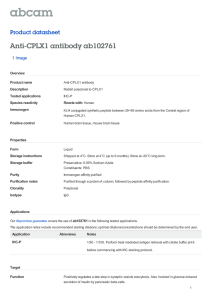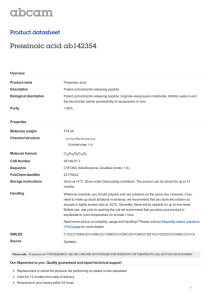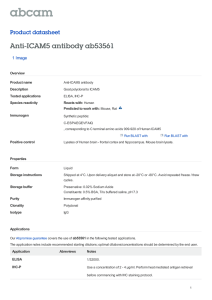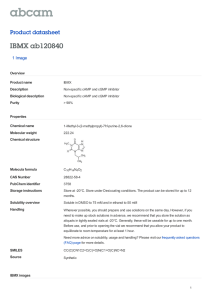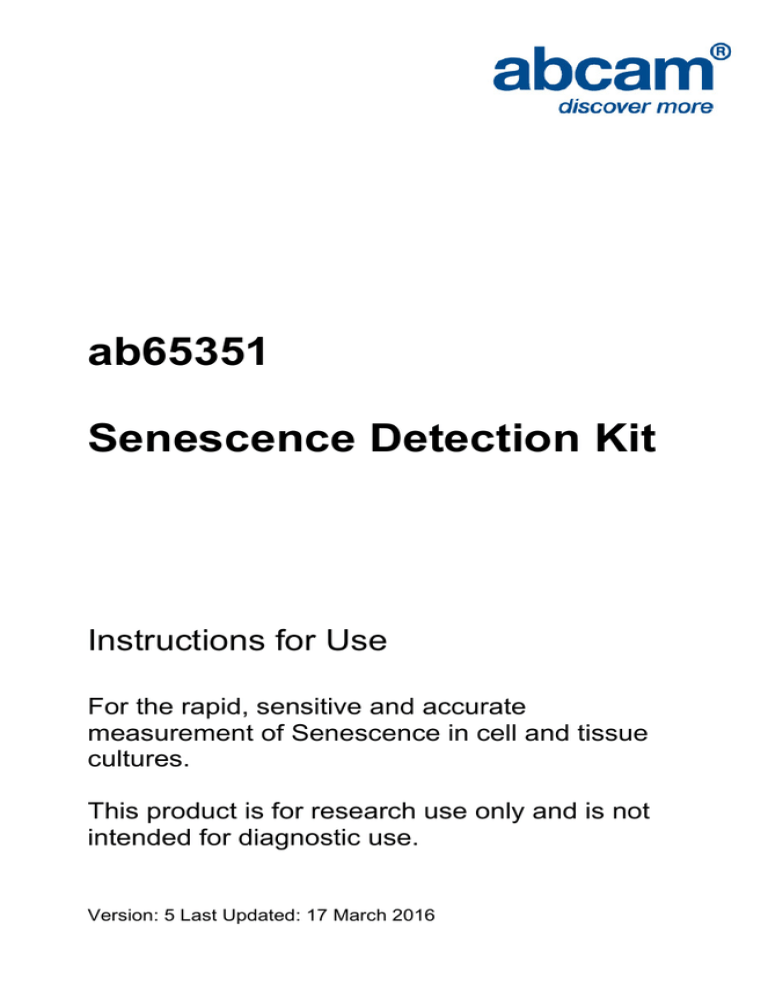
ab65351
Senescence Detection Kit
Instructions for Use
For the rapid, sensitive and accurate
measurement of Senescence in cell and tissue
cultures.
This product is for research use only and is not
intended for diagnostic use.
Version: 5 Last Updated: 17 March 2016
1
Table of Contents
1.
Overview
3
2.
Protocol Summary
3
3.
Components and Storage
4
4.
Assay Protocol
6
5.
Frequently Asked Questions
8
2
1. Overview
Senescence is thought to be a tumor suppressive mechanism and
an underlying cause of aging. Senescence represents an arrested
state in which the cells remain viable, but not stimulated to divide by
serum or passage in culture. Senescent cells display increase of cell
size, senescence-associated expression of β-galactosidase (SA-βGal) activity, and altered patterns of gene expression.
Abcam’s Senescence Detection Kit is designed to histochemically
detect SA-β-Gal activity in cultured cells and tissue sections, a
known characteristic of senescent cells. The SA-β-Gal is present
only in senescent cells and is not found in pre-senescent, quiescent
or immortal cells.
2. Protocol Summary
Reagent Preparation
Sample Preparation
Add Staining Solution
View Sample Using Microscope
3
3. Components and Storage
A. Kit Components
Item
Quantity
1X Fixative Solution
X-Gal (150 mg, Lyophilized)
125 mL
1 vial
1X Staining Solution
125 mL
100X Staining Supplement
1.5 mL
* Store kit at -20°C, protected from light. Store reconstituted X-Gal at
-20°C. All components supplied are stable for 1 year.
FIXATIVE SOLUTION, STAINING SOLUTION (1X) & STAINING
SUPPLEMENT (100X): Store at -20°C. If precipitation occurs, simply
warm up the solution to 37°C to solubilize the precipitates.
For long-term storage of the stained plates, remove the Staining
Solution and overlay the cells with 70% glycerol. Store at -20°C.
4
B. Additional Materials Required
Pipettes and pipette tips
PBS Solution
DMSO or DMF (N-N-dimethylformamide)
12 well plate
Light microscope
5
4. Assay Protocol
The following protocol is designed for each well in a 12-well plate.
For using a larger plate, increase the volume proportionally (e.g., for
6-well plate, double the volume).
1. Reagent Preparation:
a) Prepare 1X PBS Solution (not provided). Prepare 3 mL per well.
b) Prepare X-gal Solution: Weigh 20 mg X-gal, dissolve in 1 mL
DMSO or DMF (N-N-dimethylformamide, not provided) to prepare
a 20X stock solution. Excess X-gal solution can be stored at 20°C (protected from light) for one month. Always use a
polypropylene container or glass to make and store the X-gal. Do
not use polystyrene.
2. Sample Preparation:
a) Remove culture medium and wash cells once with 1 mL of 1X
PBS.
b) Fix the cells or frozen tissue sections with 0.5 mL of Fixative
Solution for 10 - 15 min at room temperature.
6
3. Staining Solution Mix: While the cells are in the Fixative
Solution, prepare the Staining Solution Mix using a polypropylene
plastic tube only. Prepare enough solution for the number of wells to
be stained.
For each well, prepare:
Staining Solution
470 μL
Staining Supplement
5 μL
20 mg/ml X-gal in DMF
25 μL
Wash the cells twice with 1 ml of 1X PBS.
4. Add 0.5 ml of the Staining Solution Mix to each well. Cover the
plate. Incubate plate at 37°C (1 hour – overnight incubation).
NOTE: CO2 levels found in general 37°C incubators will lower the
pH
of
the
staining
solution
thereby
affecting
the
color
development. We suggest putting the plate inside a Ziplock® resealable bag to avoid any effect from the CO2.
5. Observe the cells under a microscope for development of blue
color (200X total magnification).
7
5. Frequently Asked Questions
Question
Answer
Can frozen tissue
sections be used
with this kit?
The kit has been used for skin sections
successfully. Briefly, the tissue was frozen in
liquid nitrogen, and mounted in OCT. The thin
sections (4 µm) were cut, mounted onto glass
slides, fixed in 1% formalin in PBS for 1 min
at room temp., washed in PBS, immersed
overnight in beta-Gal staining solution. Then
you can view under bright field at 100-200X.
The staining results can be found in the
following article (The reference is also a
principal reference describing the senescence
marker) Dimri, G.P., et al. (1995) PNAS
92:9363-9367.
Can paraffin tissue
sections be used
with this kit?
Reference article
describing the
senescence marker?
Which cells or tissue
have been tested?
Does this kit detect
transient expression
of p53 (3-5 days) or
longer term
expression?
This has not been determined yet.
Dimri, G.P., et al. (1995) PNAS 92:9363-9367
Skin tissue section (frozen);
The Senescence Detection Kit (ab65351) will
detect senescent cells. If the p53 expressing
cells become senescent, then the kit should
detect. It does not matter what causes
senescence, but as long as cells become
senescent, the kit will detect.
8
Question
Answer
Why are some
crystals formed after
leaving overnight?
These crystals are salt crystals formed due to
the solvent evaporation. Our recommendation
is to keep the plate sealed when is left
overnight.
What if Staining
Solution and Staining
Supplement show
precipitates?
Simply warm up the solution to solubilize the
precipitates. If precipitation persists,
centrifuge the vial and use the supernatant.
For further technical questions please do not hesitate to
contact us by email (technical@abcam.com) or phone (select
“contact us” on www.abcam.com for the phone number for
your region).
9
10
UK, EU and ROW
Email: technical@abcam.com
Tel: +44 (0)1223 696000
www.abcam.com
US, Canada and Latin America
Email: us.technical@abcam.com
Tel: 888-77-ABCAM (22226)
www.abcam.com
China and Asia Pacific
Email: hk.technical@abcam.com
Tel: 108008523689 (中國聯通)
www.abcam.cn
Japan
Email: technical@abcam.co.jp
Tel: +81-(0)3-6231-0940
www.abcam.co.jp
11
Copyright © 2014 Abcam, All Rights Reserved. The Abcam logo is a registered trademark.
All information / detail is correct at time of going to print.



